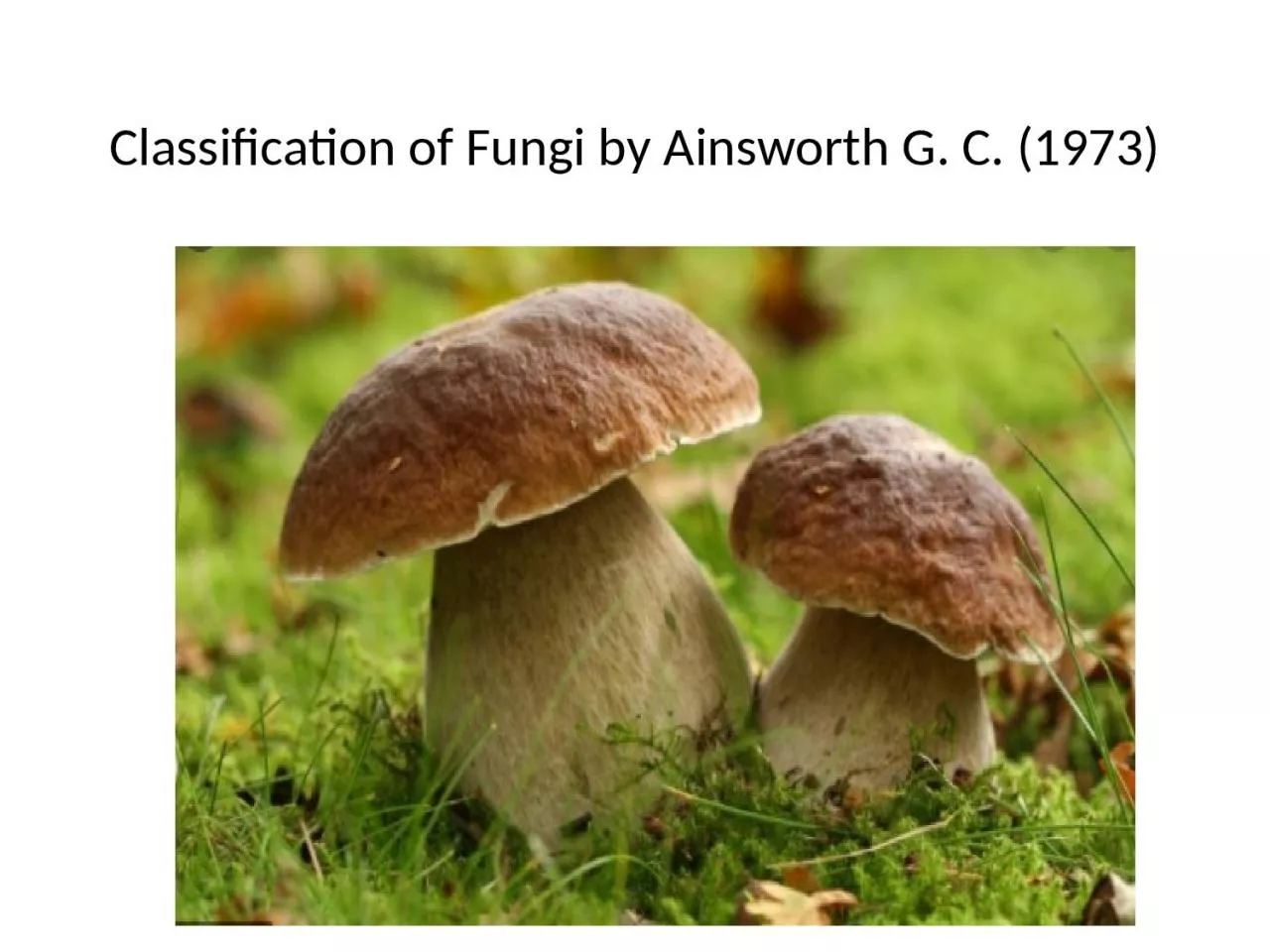

1973 Fungal Classification Initial classification based on sexual reproduction Modern classificationphylogenetic relationship using biochemical and molecular aspects Whittaker 1969 5 kingdom classification kingdom fungi ID: 1024485
Download Presentation The PPT/PDF document "Classification of Fungi by Ainsworth G. ..." is the property of its rightful owner. Permission is granted to download and print the materials on this web site for personal, non-commercial use only, and to display it on your personal computer provided you do not modify the materials and that you retain all copyright notices contained in the materials. By downloading content from our website, you accept the terms of this agreement.
1. Classification of Fungi by Ainsworth G. C. (1973)
2. Fungal ClassificationInitial classification – based on sexual reproductionModern classification-phylogenetic relationship using biochemical and molecular aspectsWhittaker (1969) – 5 kingdom classification- kingdom fungi.
3. Earlier classification of fungiBased on habitat association.3 typesTerrestrial fungi- growing in soilHypogean fungi-under the groundEpiphytic fungi- growing on plants
4. Criteria used in fungal taxonomyDayal (1975) mentioned 7 characters that are used in fungal taxonomy1. morphological charactersHost specialisationPhysiological charactersCytological and general charactersSorological charactersBiochemical charactersNumerical taxonomy
5. Fungal charactersCell wallChemical composition of cell wallSomatic phaseReproductionNutritionStructure that formed by fungi.:- fruiting bodies sporesKuraishi et al (1985)- ubiquinone systems are useful in fungal taxonomy.
6. Important systems of fungal classification1. classification by G.C AinsworthClassification by Alexopoulose.
7. Ainsworth G. C. (1973) proposed a more natural system of classification of fungi. Based on morphology, especially of reproductive structure. He includes fungi along with slime molds under the kingdom Mycota. Based on the presence or absence of Plasmodium and pseudoplasmodium-kingdom Mycota -2 division.Myxomycota (slime molds) and Eumycota (true fungi).
8.
9. Division. MyxomycotaWall-less organisms possess either a Plasmodium (a mass of naked multinucleate protoplasm having amoeboid movement) or pseudoplasmodium (an aggregation of separate amoeboid cells). Both are of slimy consistency, hence slime molds. 1. Class. Acrasiomycetes (cellular slime molds) 2. Class. Hydromyxomycetes (net slime molds) 3. Class. Myxomycetes (true slime molds) 4. Class. Plasmodiophoromycetes (endo- parasitic slime molds).
10.
11. Division Eumycotai. Free-living, parasitic or mutualistic symbionts, devoid of chlorophyll. ii. Cell wall-chitin and glucan. iii. Reserve food materials: mannitol and glycogen. iv. majority are filamentous (some unicellular)
12.
13. Division Eumycota
14. Division Eumycota (True fungi, all with walls): Subdivision:- Mastigomycotina (motile cells – zoospores present, perfect state spore-oospore).Zygomycotina (mycelium aseptate, perfect state spore-zygospore).Ascomycotina (yeasts or septate mycelium, perfect state spore- ascospores formed in ascus, usually within ascocarp). Basidiomycotina (yeast or septate mycelium, perfect state spore – basidiospore formed on a basidium). Deuteromycotina or Fungi imperfecti. Yeast or septate mycelium. Perfect state unknown.
15. Subdivision Mastigomycotina1. Class. Chitridiomycetes (unicellular, zoospore with single whiplash flagellum). 2. Class. Hyphochytridiomycetes (unicellular, zoospore with single tinsel flagellum). 3. Class. Oomycetes (aseptate mycelium, zoospores with two flagella).
16.
17. Subdivision. Zygomycotinamycelium aseptate, perfect state spore-zygospore.1. Class. Zygomycetes (mycelium immersed in the host tissue). 2. Class. Trichomycetes (mycelium not immersed in the host tissue).
18.
19. Subdivision. AscomycotinaAscomycotina (yeasts or septate mycelium, perfect state spore- ascospores 1. Class. Hemiascomycetes (no ascocarp, asci naked). 2. Class. Loculoascomycetes (fruit body an ascostroma, asci bitunicate i.e., 2-walled). 3. Class. Plectomycetes (fruit body cleistothecium, asci unitunicate i.e., 1-walled). 4. Class. Laboulbeniomycetes (fruit body perithecium, asci unitunicate, exoparasite of arthopods).
20. 5. Class. Pyrenomycetes (fruit body perithecium, asci unitunicate, not parasitic on arthopods. 6. Class. Discomycetes (fruit body apothecium, asci unitunicate).
21. Sub division- Ascomycotina
22. Subdivision. BasidiomycotinaBasidiomycotina (yeast or septate mycelium, perfect state spore – basidiospore formed on a basidium). 1. Class. Teliomycetes. Basidiocarp lacking, teliospores grouped in sori or scattered within the host tissue, parasitic on vascular plant. 2. Class. Hymenomycetes. Basidio- carp present. Hymenium is completely or partly exposed at maturity. Basidiospore ballistospores. 3. Class. Casteromycetes. Basidiocarp present. Hymenium enclosed in basidiocarp. Basidiospore not ballistospores.
23.
24. Subdivision. DeuteromycotinaSubdivision. Deuteromycotina or Fungi imperfecti. Yeast or septate mycelium. Perfect state unknown.1. Class. Blastomycetes. Budding (Yeast or Yeast like) cells with or without pseudomycelium. True mycelium lacking or not well-developed. 2. Class. Hyphomycetes. Mycelia sterile or bearing asexual spore directly or on conidiophore, in various aggregation. 3. Class. Coelomycetes. Mycelial; asexual spore formed in pycnidium or acervulus.
25.
26. Ten years after the classification of Ainsworth (1973), Hawksworth et al. (1983) revised Ainsworth’s classification in the 7th edition of the “Dictionary of the Fungi”. The changes made by them are: 1. The Division Myxomycota divided into eight classes instead of four classes. 2. The Sub-division Ascomycotina is directly divided into thirty seven (37) orders and arranged alphabetically; there is no classes in-between. 3. The subdivision Basidiomycotina is divided into four classes instead of three, where class Teliomycetes is replaced by Uredinio- mycetes and Ustilaginomycetes. 4. In the sub-division Deuteromycotina, the class Blastomycetes was not considered.
27. Later, Hawksworth et al. (1995) thoroughly revised the classification in the 8th edition of the “Dictionary of the Fungi”. The classification was based on the sequence of 18s rRNA among the different members. Though members of fungi show similarity in their morphology, mode of nutrition and ecology, but the higher dissimilarity is observed in the base sequences of their 18s rRNA (or more precisely in the DNA coding for it), which is now considered as the most important parameter to determine the genetic relationship. Thus, it shows that the fungi are polyphyletic aggregation of unrelated members. Based on the above fact and phylogenetic consideration, the entire fungal community are now segregated out and placed them under three different Kingdoms Fungi, Straminopila (Chromista) and Protozoa.
28.
29.
30.
31.
32.
33.